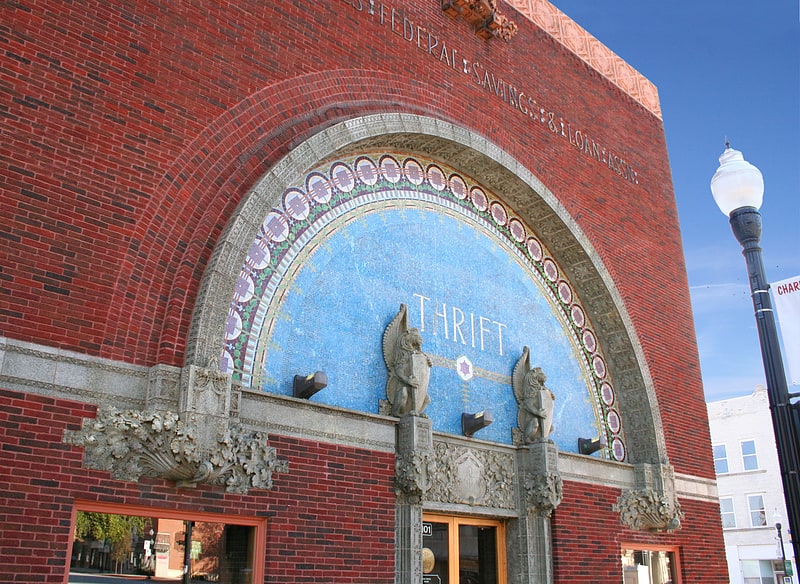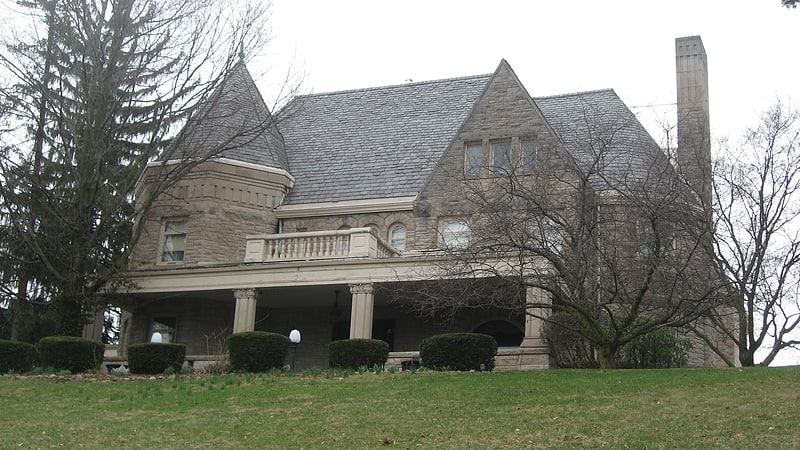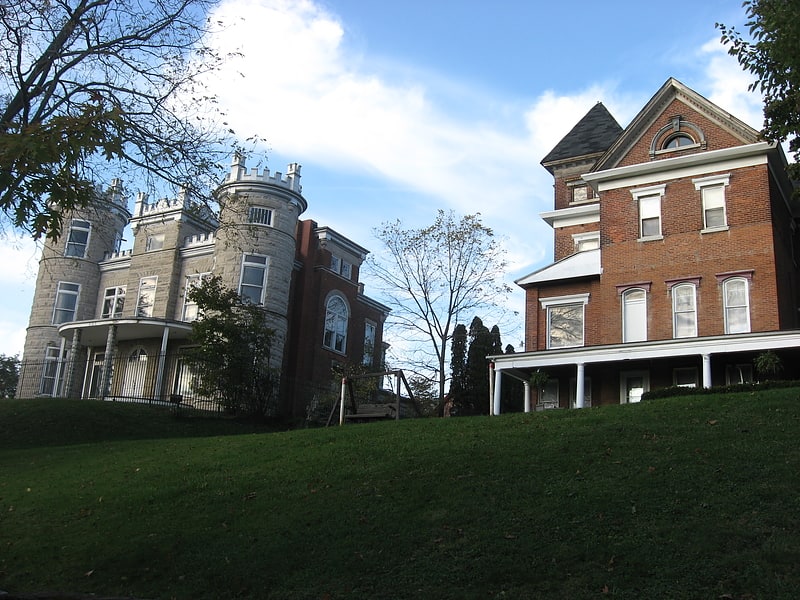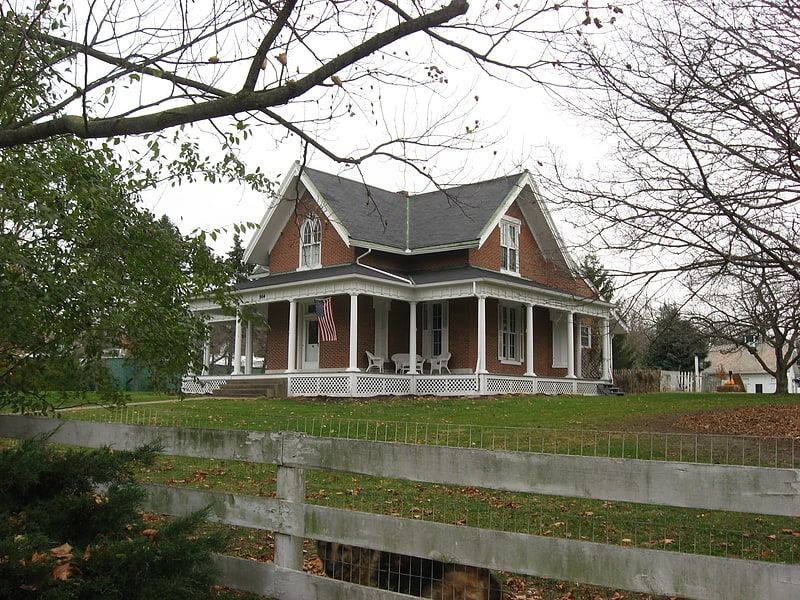Discover 5 hidden attractions, cool sights, and unusual things to do in Sidney (United States). Don't miss out on these must-see attractions: People's Federal Savings and Loan Association, Whitby Mansion, and Shelby County Fair - Sidney. Also, be sure to include Sidney Walnut Avenue Historic District in your itinerary.
Below, you can find the list of the most amazing places you should visit in Sidney (Ohio).
Table of Contents
People's Federal Savings and Loan Association

Bank in Sidney, Ohio. The People's Federal Savings and Loan Association is a historic bank building at 101 East Court Street in Sidney, Ohio, designed by Chicago architect Louis Sullivan. It was designed and built in 1917 for use by Peoples Federal Savings and Loan Association, which still operates out of it. It is one of a handful of banks designed by Sullivan between 1908 and 1919 for small communities in the central United States. The building is a National Historic Landmark.[1]
Whitby Mansion

Mansion in Sidney, Ohio. The Whitby Mansion is a historic mansion in Sidney, Ohio, United States. Built in 1890, it was originally the home of W.H.C. Goode, a Sidney industrialist. Descended from one of the First Families of Virginia, Goode first purchased property in the vicinity of Sidney in 1849. Having gained complete ownership of the leading steel scraper manufacturing company in the United States in 1877, Goode began to build his mansion on Sidney's northern side in the late 1880s. The resulting mansion, designed by an unknown architect, features massive stone walls that are topped with a slate roof. Elements of the Jacobethan and Châteauesque styles are combined with the Tudor Revival style of architecture. By the mid-1970s, the mansion had ceased to be a house; it had been purchased by The Way International and converted into a historic archive and art museum. Today, the property is owned by GreatStone Castle Resorts, which operates it as a bed and breakfast.
In 1976, the Whitby Mansion was listed on the National Register of Historic Places because of its historically significant architecture. It was seen as historically significant primarily as a leading example of the architecture of the rich in late nineteenth-century America.[2]
Shelby County Fair - Sidney

View point, Relax in park, Park
Address: 653-659 S Highland Ave, 45365 Sidney
Sidney Walnut Avenue Historic District

Historical place in Sidney, Ohio. The Sidney Walnut Avenue Historic District is a neighborhood and historic district on the western side of the city of Sidney, Ohio, United States. Located a short distance northwest of the city's downtown, the Walnut Avenue District has been Sidney's premier residential neighborhood since its creation in the late nineteenth century.
Fifteen houses compose the district, which is located on the sides and top of a small hill. Twelve of the fifteen are located along Walnut Avenue, and the other three line North Street; they were built in such styles as Queen Anne, Greek Revival, and Italianate. Common construction materials include stone foundations, brick walls, and slate roofs. Although the oldest property in the district dates back to 1847, and the newest to 1913, the majority of the district's houses were built in the last years of the nineteenth century, and most houses in the neighborhood that are significantly older were extensively modified at that time. During the late nineteenth century, Sidney was passing through a period of transformation: since its establishment in 1820, its identity was that of a small county seat in an agricultural region, but by the end of the century, institutions such as the People's Federal Savings and Loan Association were causing it to gain prominence in commerce, industry, and banking. Leading members of the city's society, such as factory owners, bankers, and businessmen built large homes on the hillside along Walnut Avenue, and it became known as the city's élite residential neighborhood. Among its most important residents were jeweller Edward Kah, merchant Elias Griffis, garden company owner Bernard Wagner, and educator Herbert McVay.
At the end of 1983, the Sidney Walnut Avenue Historic District was listed on the National Register of Historic Places. The district qualified for inclusion under two separate criteria: it was eligible because of its place in local history, and it was similarly eligible because of the distinctive historic architecture of the buildings within its boundaries. It was the last of Shelby County's three historic districts to be added to the Register, following the Lockington Locks by fourteen years and the Sidney Courthouse Square by three years.[3]
Fulton Farm

Building in Sidney. The Fulton Farm, also known as "River Bend Farm," is a historic farmstead in Shelby County, Ohio, United States. Located on the southern side of the city of Sidney, the farm is composed of five buildings spread out over an area of approximately 2 acres. Built primarily in 1848, the distinctively Gothic Revival farm buildings are a leading element of Shelby County rural architecture; few pre-Civil War farmhouses elsewhere in the county are more elaborate. Besides the farmhouse, the complex includes four less important buildings, two brick and two wooden: a smokehouse, a carriage house, and two smaller barns.
Prominent farmer Isaac Fulton built the one-and-one-half story farmhouse and other buildings for his wife, the former Jane Taylor, soon after their 1848 wedding. The construction, which was not finished until 1850, was almost entirely Fulton's work; he even made the bricks by himself. Fulton used an unusual floor plan; the house's footprint is asymmetrical, and its windows are a mix of trabeated and traditional Gothic Revival styles. A rectangle large enough to support the entire house would measure approximately 50 feet (15 m) by 42 feet (13 m).
In 1979, the Fulton Farm was listed on the National Register of Historic Places. It qualified for inclusion on the Register because of its impact on two different areas of local history: its well-preserved historic architecture and its place in the development of agriculture in central Shelby County.[4]